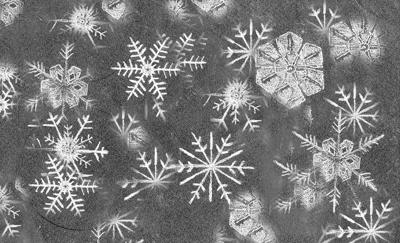By MEGHAN MCCARTHY MCPHAUL
The other day I was driving through New Hampshire’s Crawford Notch, where my eyes are usually drawn to the tall mountains and long, cascading waterfalls on either side of the road. But on this day, my gaze shifted toward the snowbanks lining the narrow highway. The sun was shining and the landscape glittered. The sparkle of sunlight on cold white reminded me of childhood trips, when I would look out the backseat window at passing fields and imagine all those tiny glimmers were winter fairies, twirling and skipping through the snow. Snow sparkle isn’t (as far as science has revealed) attributable to fairies, but to light bouncing off the snow at multiple angles.
“When you have a really cold snowfall, you tend to get a bunch of little individual plates,” explained Adam Gill, a weather observer and meteorologist with the Mount Washington Observatory. “It’s like billions of these little tiny reflectors all over the ground. If there’s a bright light source, if you’re at the correct angle, that light source will reflect back at you.”
As we move across the landscape, our angle changes, and light flashes from different directions. In addition to temperature considerations, the extent of sparkle can depend on several other factors.
Beyond Wilson “Snowflake” Bentley’s famous observation that no two snowflakes are alike, there are some basic variations in how these tiny structures develop on their fall through the air. A snowflake forms when a water droplet freezes onto a dust particle and crystalizes. As that crystal descends, water vapor freezes onto it, forming new crystals – and creating the characteristic six-sided snowflake formation. Although some whimsical depictions of snowflakes show a different number of sides, or arms, snowflakes are almost always hexagonal because of the way water molecules bond to each other as they crystalize.
Sometimes snowflakes’ arms – or sides – take the form of columns, sometimes needles. Sometimes, in warmer weather, flakes clump together. Snow falling in very cold temperatures tends to form very small flakes – too small to create much flash.
The best snowflakes for creating snow sparkle, Gill said, are those that fall when temperatures are between about 5 and 15 degrees, when snowflakes tend to form as thin, flat plane crystals. Still air conditions also contribute to sparkle. Too much wind breaks the snowflakes into smaller pieces and diminishes their reflective capacity. Snow that’s settled for more than a few days also tends to lose its shine.
“You need a storm with very little wind, where you get at least a couple inches of snow,” Gill said. “New snow definitely sparkles more than old snow, because eventually all the plates disintegrate as they start to melt, so they don’t act like little mirrors anymore.”
Light quality is also important. Bright sunshine, or a bright full moon, can create sparkle.
“If it’s cloudy, the light gets dispersed in all directions,” said Gill. “You don’t see the sparkle, because it’s not a focused light.”
Even on a dark and cloudy night, if other conditions are right, you can still create sparkle by using a flashlight or another source light directed from a focal point. Beyond the science, there is magic in the dance of light on diminutive specks of frozen water. Vermont’s Wilson Bentley called snowflakes “tiny miracles of beauty,” and I agree that’s what they are – whether falling from a clouded sky or shimmering in the sun.
Meghan McCarthy McPhaul is an author and freelance writer from Franconia, N.H. The Outside Story is assigned and edited by Northern Woodlands magazine and sponsored by the Wellborn Ecology Fund of New Hampshire Charitable Foundation.















(0) comments
Welcome to the discussion.
Log In
Keep it clean. Please avoid obscene, vulgar, lewd, racist or sexual language.
PLEASE TURN OFF YOUR CAPS LOCK.
Don't threaten. Threats of harming another person will not be tolerated.
Be truthful. Don't knowingly lie about anyone or anything.
Be nice. No racism, sexism or any sort of -ism that is degrading to another person.
Be proactive. Use the "Report" link on each comment to let us know of abusive posts.
Share with us. We'd love to hear eyewitness accounts, the history behind an article.